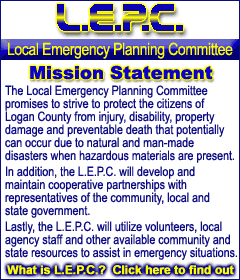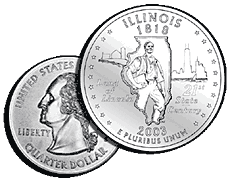|
 |
Thursday, Oct. 10 |
|
|
|
An
over-the-counter tiger
is devouring our children
[OCT. 10, 2002]
The inquest jurors were mute
when Logan County Coroner Chuck Fricke concluded his presentation of
facts and witnesses in the death of a 16-year-old Lincoln youth,
Sean M. Riggins. Sean died of a heart attack on Sept. 3.
|
|
Sean’s father, Kevin Riggins, described
his son as a healthy, adventurous athlete who loved life. He said
Sean would never knowingly have put anything into his body that he
thought would harm him. Fricke said toxicology results bore that
out.
Yet, this apparently healthy, young
athlete did die, and he died from something he put into his body.
What came to light during the
testimonies was shocking. The revealed activities of other young,
healthy, energetic students was something no one — not law
enforcement, not school authorities, not coaches and especially not
parents — were prepared for. The rampant use of dangerous
over-the-counter drugs is sweeping our local youth. Our high school
students have been heavily involved in the use of ephedrine
products, both as athletic enhancers and for recreational use.
Students eventually reported that
several ephedrine products were being passed around on bus trips
while en route to athletic events. Some young people were using them
during recreation times as well. The particular products being used
produce effects much like amphetamine street drugs. Students were
using ephedrine products and spiking them with high caffeine drinks.
The students liked the benefits and sensations produced and were
using them as stimulants for both athletic purposes and recreational
pleasure.

The chemical constituents of ephedrine
are said not to be toxic by themselves. It is when combined with
additional drugs, such as caffeine, which increases the amount and
speed that it is delivered into the circulatory system, that
ephedrine products become dangerous. The quantity of active
ingredients in each capsule and the packaging and labeling of the
products is regulated by the FDA. However, to gain the desired
effects students often joint the products with high caffeine drinks.
Fricke gave a chronology of his
investigation and then called forth three witnesses. On Wednesday,
Sept. 4, the day after Sean’s death, he received a call from the
mother of a girl suffering symptoms similar to those Sean
experienced. The girl had been to Clinton Lake just as Sean had on
the Saturday before. The mother was concerned that maybe there was
something wrong with the water there. Through a series of events
including contacting the public health departments and schools, a
nurse finally broke the cloud of mystery: "The kids were yellow
jacketing and jointing."
This was the first Fricke had heard of
such a thing. He began researching. He found a number of different
products readily available containing the key ingredient in Yellow
Jackets, ephedrine, readily available for anyone to purchase in
local stores. He purchased a couple, a package of 3/$1.50 Yellow
Jackets and a bottle containing 60 ephedrine. The label on a package
of Yellow Jackets says that it is "An herbal dietary supplement and
an extreme energizer. Not to be sold to minors, which is
prohibited."
Fricke contacted the Lincoln Police
Department and asked for their assistance in the investigation.
Detective Michael Harberts worked with Detective John Bunner on the
case.
Harberts said that he had not heard of
Yellow Jackets jointing previously. They began by speaking with
Sean’s parents. Sean’s parents also had never heard of this. They
went to Lincoln Community High School and spoke with Superintendent
Fred Plese, head football coach John Oaks and athletic director
Darrell Hanslow. All of them were "totally unaware" of any students
or athletes using these products or yellow jacketing. "They were
shocked," Harberts said.
A friend and teammate to Sean
eventually came forth and broke the silence. He told the detectives
that the day before Sean died (Monday) they had a football game
against Olympia. "Most of the football players were taking Yellow
Jackets on the bus going there and after they got to the stadium.
Some of the kids became ill, nauseated. Sean had become nauseated
and couldn’t play in the game." The coaches thought it was just the
heat. It was in the upper 90s that day.
Bunner believes the students were
taking it with the intent of athletic enhancement just the way
people drink coffee to be more alert. It made them more energetic.
Bunner also explained that Illinois
does not restrict the sale of these products. He read a label,
"Abuse of this product could be fatal. Do not sell to minors.
Distribution of this product requires a DEA license." The warning is
a self-regulating measure by the manufacturer. A DEA license is not
known to anyone, including former DEA agent, Sen. Dick Durbin.
Which, Fricke suggests, indicates that some of these products are
mislabeled or misleading.
Sgt. Ken Greenslate, who works with
youth, was asked to assist with the investigation. He interviewed
students, trying to narrow down how much ephedra Sean was taking in
the days before his death. During his interviews with students no
one could say just how much he was taking. Friends recalled that
Sean had nausea and dry heaves on Saturday. They said he felt tired
or puny on Sunday. Another teammate said that on Monday, Sean was
feeling poorly and he was unable to play in the game.

[to top of second column in
this article]
|

Students said that it was not just one
person passing products, and not just one ephedra product was being
passed around. No one actually saw anyone give Sean the product. Nor
did anyone see him taking the product, but several knew that he had
taken it.
Sean’s parents, Kevin and Debbie, spoke
with his friends and tried to convey to them the importance of
knowing just how much and how Sean had taken the ephedrine products.
They wanted to know just what had killed their son and hopefully
prevent it from happening to any other family.
Eventually they received 14 handwritten
letters from Sean’s friends documenting the use of the products,
including Yellow Jackets, Stacker 2 and some others. The students
documented that they used them for several reasons — for weight
loss, to get pumped for football games; and some said they enjoyed
the thrill of feeling their heart beat real fast, and it gave them a
buzz or rush.
The Rigginses were left with the clear
impression that students did not know anything about the product.
Kevin Riggins added, "I know how my son was. He was not a drug user,
didn’t smoke, nothing of that sort. If he had known what this stuff
could do, he would not have taken it."
The forensic pathologists’ portion of
the investigation determined the manner of death. The autopsy was
performed by Dr. Michael A. Markey and Dr. Kent Harshbarger at
Memorial Medical Center, Springfield. Following postmortem
examination and various laboratory tests, they gave an opinion that
Riggins died of acute myocardial infarction. The heart was mildly
enlarged with diffuse mottling of the myocardium. Other notable
findings included an enlarged congested spleen, fatty change of the
liver, small nodules at the periphery of the lungs. Toxicology
results of the urine revealed ephedrine and/or pseudo-ephedrine
product.
Their report stated, "Ephedra
alkaloids, including ephedrine, have significant physiological
effects on the cardiovascular system. These effects include
elevation of blood pressure and cardiac stimulation. A variety of
deaths have been attributed to ephedrine and include cases of acute
myocardial infarction, likely due to its vaso constriction
properties. It is our opinion that Sean’s heart attack is consistent
with the effects of ephedrine. There were no other abnormalities of
the coronary arteries."

Sean’s father gave an account of Sean’s
last few days alive. Saturday he seemed fine at home. He ate like
normal. He went with his friends out to Clinton Lake. His parents
had no idea that he had been sick that day when he went to stay the
night at his friend’s house. Sunday he took off to play with his
friends. He was the type of kid that if he wanted to do something he
wouldn’t say if he didn’t feel well.
On Monday Sean complained of his
stomach hurting and headache. He was tired. His father attributed it
to a busy weekend. He’d spent the night at his friend’s house twice,
been to the lake twice, had football practice Saturday — a typical
weekend for Sean.
He rested all day but still went to his
football game. Sean said he was "feeling a little iffy."
Tuesday morning he got up and told his
mother, Debbie, that he didn’t feel like going to school. A little
later he asked to go to the doctor. He was diagnosed with
bronchitis. He was given a shot of Pancof for his nausea, cough
medication and antibiotics. He went home and rested.
Fricke interjected that ephedrine is
often used as an asthma medication. The effect of ephedrine as a
bronchial dilator would present to a doctor as bronchitis.
Sean’s mother kept check on him. While
he was sleeping he began to mumble in his sleep. She went over to
him, and he had stopped breathing. She began CPR and called for
help.
He was taken by rescue personnel to
ALMH. They began testing for a heart attack. His treponin was almost
100. Normal ranges are one or two. A mild heart attack is four to
five.
The cause of death, heart attack, given
by the forensic pathologists was determined from medical, toxicology
and autopsy evidences.
After
hearing the overwhelming evidence from the toxicology report and the
testimony of witnesses, the jurors had no questions before retiring
to make their decision as to the manner of his death. They came back
in a few short minutes having determined his death as "accidental
but avoidable."
[Jan
Youngquist] |
|
 |
|
|
Ephedra on trial: Metabolife, Yellow Jackets cause health
problems, death
[OCT. 10, 2002]
WASHINGTON, D.C. — At a Senate subcomittee hearing
chaired Tuesday by U.S. Sen. Dick Durbin, D-Ill., the Illinois
senator renewed his call to the Bush Administration and the U.S.
Food and Drug Administration to take immediate action to protect the
public from the threat posed by ephedra-containing dietary
supplements.
|
|
The hearing, held by
the Governmental Affairs Subcommittee on Oversight of Governmental
Management, Restructuring, and the District of Columbia, focused on
what government agencies and private organizations are doing to
protect consumers from harm from ephedra-containing dietary
supplements and contrasted the U.S. approach with the approach taken
by other countries. This was the second major hearing on dietary
supplements chaired by Durbin in the past six months.
Durbin said the list
of problems associated with ephedra is growing and the federal
government must act.
"Today I am again
asking the secretary of health and the FDA to take meaningful action
to address the public health threat posed by the dietary supplement
ephedra, and to use their authority to suspend the sales of the
product in the U.S. until we can ensure that it is safe," said
Durbin.
"So far, we have seen
a reluctance on the part of this administration to act to protect
American consumers from this product, and I just can’t understand
it. We have mountains of evidence that this drug is not safe, and
these manufacturers are being irresponsible about their marketing
practices. We have a dead child in Illinois; we have FDA reports
that link ephedra to 81 deaths and 1,400 incidents of heart attacks,
high blood pressure and stroke; we have companies marketing this
‘natural product’ as an alternative to cocaine and speed. What more
does it take? How many more kids do we have to bury before we say
‘enough is enough’?"

Testifying at the
hearing were Kevin and Debbie Riggins, parents of a 16-year-old
Illinois teen who died after consuming an ephedra product, and Chuck
Fricke, the county coroner who investigated. Sean Riggins, a high
school student from Lincoln, Ill., died of heart failure after
consuming a dietary supplement product known as Yellow Jacket. The
Logan County coroner testified that the death was directly related
to consumption of this product. Riggins, who was on both the high
school football team and wrestling team, had no pre-existing heart
conditions and had passed a physical just one month prior to his
death.
"It is so hard to
come to grips with the death of our son," said Debbie Riggins. "In
what way do these companies differ from drug peddlers? Contract
killers? They are making a product, packaging it, wholesaling it,
distributing it, having others sell it for them so you don’t see
their faces; so the common man doesn’t know where to go if he has a
question or needs help. The only difference that I see is how the
law is written, or rather no law is in place."
On Tuesday, the FDA
requested a search warrant for the New Jersey facilities of NVE
Pharmaceuticals, producers of Yellow Jackets. The Food and Drug
Administration has also reported that they are stopping the imports
of these pills. The FDA has contacted a Dutch company that is
advertising the pills over the Internet as alternatives to cocaine
and other street drugs, informing the company that this kind of
advertising is illegal.

[to top of second column in
this article]
|

FDA Acting
Commissioner Lester Crawford warned, "Consumers should not purchase
or use these or similar products available through the Internet or
elsewhere."
The issue with Yellow
Jackets themselves is separate, focusing on illegal advertising
rather than ephedra’s safety.
The ephedra hearing
also examined the current voluntary adverse event reporting system —
AER — for dietary supplements and whether this system is adequate to
protect public health. As part of this analysis, the Senate and
House oversight committees reviewed 13,000 AERs received by
Metabolife, the largest manufacturer of ephedra-containing dietary
supplements in the U.S.
The committee found
that Metabolife records include nearly 2,000 reports of significant
adverse reactions to Metabolife products. The company had previously
claimed that fewer than 80 of the AERs they submitted to the FDA
could be classified as serious.
The adverse events
reported to Metabolife by consumers of its products include three
deaths, 20 heart attacks, 24 strokes, 40 seizures, 465 episodes of
chest pains and 966 reports of heart rhythm disturbances. In
addition, the reports contain hundreds of consumer complaints of
high blood pressure and disturbing psychiatric symptoms, such as
anxiety, mood changes or psychosis. In at least 46 instances,
consumers reported that they required hospitalization following use
of Metabolife products, and in at least 82 additional instances,
consumers reported that they required emergency room care.
The committee
analysis of the Metabolife records indicate that many of the
significant adverse events involve consumers who were young, in good
health and taking recommended dosages. Metabolife has asserted that
adverse events do not occur when healthy individuals follow
Metabolife’s recommended dosages. The actual adverse event reports,
however, include many reports of significant health effects in
healthy consumers taking recommended dosages. Among the most
significant adverse event reports (those involving heart attacks,
seizures, strokes and psychosis), over 90 percent of the reports
where dosage information is noted involve consumers who were taking
the dosage recommended by Metabolife.
Also testifying at the hearing were
Howard Beales, director of the Bureau of Consumer Protection at the
Federal Trade Commission; Bill Jeffery of the Center for Science in
the Public Interest—Canada; Dr. Ron Davis, of the board of trustees
of the American Medical Association; Dr. Sid Wolfe, director of the
Public Citizen Health Research Group; Frank Uryasz, of the National
Collegiate Athletic Association; a representative from Metabolife
International; and Dr. Lester Crawford, acting commissioner with the
U.S. Food and Drug Administration.
[Press release from U.S. Sen.
Dick Durbin; LDN] |
|
 |
|
|
Chamber prepares for
Christmas parade
[OCT.
10, 2002]
Lincoln’s annual Christmas parade downtown will be on
Thursday, Dec. 5, at 7 p.m. "Let Your Spirits Soar" is the theme for
this year’s parade, co-sponsored by the Lincoln/Logan County Chamber
of Commerce and the city.
|
|
The chamber is
accepting entries from businesses, industry, governmental agencies,
schools, civic and not-for-profit groups, and religious, youth and
charitable organizations. Let your imaginations soar to new heights
with expressive interpretations of the parade theme. There is no
charge to enter, and cash prizes will be awarded.
The evening parade
features marching bands, lighted floats and vehicles, and military
marching units. Groups are encouraged to use motorized vehicles in
an attempt to reduce the number of walking entries.
"We’re also looking
for a business or a group to sponsor the Santa Claus float," says
Bobbi Abbott, chamber director. "The parade’s final entry is the
Santa float, and it needs to be impressive!"
Interested participants may call 735-2385
or e-mail
chamber@lincolnillinois.com for an entry form or further
information.
[Lincoln/Logan
County Chamber of Commerce
press release] |


|
|
|
 Illinois commemorative Illinois commemorative
quarter design chosen
[OCT. 10, 2002]
CHICAGO — The design for the
Illinois commemorative quarter has been made public. Gov. George
Ryan announced the design on Tuesday at the Federal Reserve Bank of
Chicago. The Illinois quarter, first in the 50 State Quarters
Program to be released in 2003, will pay tribute to Illinois’
heritage and to the state’s past, present and future role as a
leader in agriculture and industry.
|
|
"The Illinois commemorative quarter
will encourage the youth of the United States to explore Illinois,
its history and geography, as well as the rich diversity of our
heritage," said Gov. Ryan. "I am proud that Lincoln is standing
boldly in the center of the design. His resolve and example mean a
great deal to people in Illinois and throughout the world."
The design incorporates a farm setting
and the Chicago skyline, along with a young Abraham Lincoln
superimposed on an outline of the state. Also included is the state
slogan, "Land of Lincoln," as well as 21 stars and the inscription
"21st State/21st Century." The design was inspired by artwork
submitted to the governor by Thom Cicchelli of Chicago.
The image of Lincoln in the design is
from "The Resolute Lincoln," a sculpture by Avard Fairbanks that
depicts Lincoln at a pivotal time in his development. The work by
Fairbanks is meant to reflect a turning point in Lincoln’s career
and the changes that Lincoln went through during the six years he
spent in New Salem, as he resolves to put down the ax and pick up
the book. The statue, dedicated in 1954 as a gift to the state from
the National Society of the Sons of Utah Pioneers, is located at the
New Salem State Historic Site.

The "Land of Lincoln" slogan was
adopted in 1955 by the General Assembly. In that same year, the U.S.
Congress passed a special act granting Illinois a copyright for
exclusive use of the "Land of Lincoln" insignia. The inscription
"21st State/21st Century" describes Illinois’ historical role as the
21st state to ratify the Constitution and the state’s present and
future role in the Union.
"Illinois is recognized internationally
as a leader in agriculture and industry, and we have worked hard for
decades to build the best cities, farms and schools to support our
leadership role," said Gov. Ryan. "I can think of no better design
to illustrate the accomplishments of past, present and future
generations."
[to top of second column in
this article] |

In January 2001, Gov. Ryan announced a
public input period, sponsored a statewide quarter design program
for students and adults, and launched a website to help facilitate
the design selection process for the commemorative quarter. He also
formed a review committee comprised of educators, state personnel
and numismatists. In addition, first lady Lura Lynn Ryan invited 14
teenagers to serve on a Futures for Kids review panel.
The governor received over 6,000 ideas
for the Illinois quarter via mail and e-mail. Based on
recommendations from the quarter committee and youth panel, he
forwarded five themes to the U.S. Mint in April 2001. The Mint
created candidate designs based on the themes and recently presented
them to the governor and first lady for their final selection.
The commemorative quarters program is a
10-year initiative, beginning in 1999 and concluding in 2008,
commemorating each of the 50 United States. Quarters are issued in
the order in which the states ratified the Constitution and joined
the Union. Illinois will be honored in 2003, along with Alabama,
Maine, Missouri and Arkansas. State designs are displayed on the
reverse of the quarters. The obverse of the quarters will continue
to display the image of George Washington.
For more
information on the Illinois commemorative quarter, visit
http://www.state.il.us/state/quarter/default.htm.
[Illinois
Government News Network
press release]
 |
|
|
Articles from the past week |
|
Wednesday:
-
Local authorities still searching for clues in
16-year-old's death -
Lincoln one of 31 water treatment
plants receiving low-interest state loans -
‘Back Talk’ airs this Friday on WMNW
(Business)
Tuesday:
-
Council mourns loss of Alderman Stone -
Miller receives first firefighter
award -
City, firefighters reach contract
agreement -
Body found in Salt Creek
Monday:
|
Saturday:
-
Chester-East Lincoln School seeks funds
through referendum -
Lincoln College president announces his retirement -
Warm, dry summer follows warm, wet spring
Friday:
Thursday:
|
|
Back
to top
|
News
| Sports
| Business
| Rural
Review |
Teaching
& Learning |
Home
and Family |
Tourism
| Obituaries
Community |
Perspectives |
Law
& Courts |
Leisure Time |
Spiritual
Life | Health
& Fitness |
Calendar
Letters
to the Editor
|
|